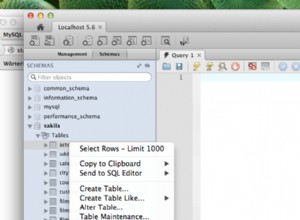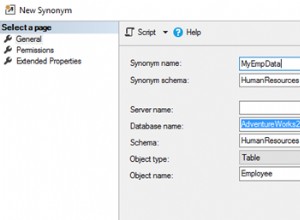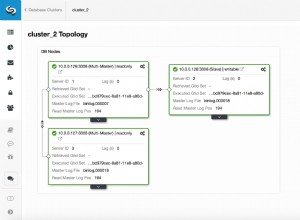Situation classique que tout le monde a. Vous pouvez former dynamiquement une chaîne de requête basée sur votre tableau ou quelque chose. Et utilisez-le comme OPEN CURSOR. .
DECLARE
v_mystring VARCHAR(50);
v_my_ref_cursor sys_refcursor;
in_string varchar2='''abc'',''bcd''';
id2 varchar2(10):='123';
myrecord tablename%rowtype;
BEGIN
v_mystring := 'SELECT a.*... from tablename a where name= :id2 and
id in('||in_string||')';
OPEN v_my_ref_cursor FOR v_mystring USING id2;
LOOP
FETCH v_my_ref_cursor INTO myrecord;
EXIT WHEN v_my_ref_cursor%NOTFOUND;
..
-- your processing
END LOOP;
CLOSE v_my_ref_cursor;
END;
La clause IN prend en charge un maximum de 1 000 éléments. Vous pouvez toujours utiliser une table pour vous joindre à la place. Cette table peut être une Global Temporary Table(GTT) dont les données sont visibles pour cette session particulière.
Vous pouvez toujours utiliser une nested table aussi pour cela (comme la table PL/SQL)
TABLE() convertira une table PL/Sql en un objet de table compréhensible SQL (un objet en fait)
Un exemple simple ci-dessous.
CREATE TYPE pr AS OBJECT
(pr NUMBER);
/
CREATE TYPE prList AS TABLE OF pr;
/
declare
myPrList prList := prList ();
cursor lc is
select *
from (select a.*
from yourtable a
TABLE(CAST(myPrList as prList)) my_list
where
a.pr = my_list.pr
order by a.pr desc) ;
rec lc%ROWTYPE;
BEGIN
/*Populate the Nested Table, with whatever collection you have */
myPrList := prList ( pr(91),
pr(80));
/*
Sample code: for populating from your TABLE OF NUMBER type
FOR I IN 1..your_input_array.COUNT
LOOP
myPrList.EXTEND;
myPrList(I) := pr(your_input_array(I));
END LOOP;
*/
open lc;
loop
FETCH lc into rec;
exit when lc%NOTFOUND; -- Your Exit WHEN condition should be checked afte FETCH iyself!
dbms_output.put_line(rec.pr);
end loop;
close lc;
END;
/




